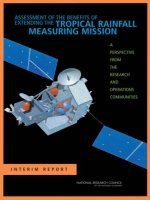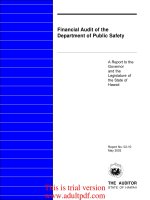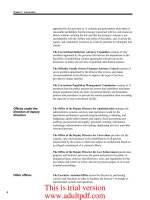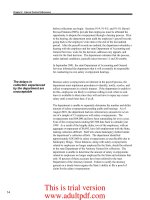A LIST OF THE LAND AND SEA MAMMALS OF NORTH AMERICA, ELLIOT 1901
Bạn đang xem bản rút gọn của tài liệu. Xem và tải ngay bản đầy đủ của tài liệu tại đây (3 MB, 64 trang )
FIELD COLUMBIAN MUSEUM
PUBLICATION 57.
ZOOLOGICAL SERIES.
VOL.
A
II,
No.
LIST
OF THE
LAND AND SEA MAMMALS
OF
NORTH AMERICA
NORTH OF MEXICO.
SUPPLEMENT TO THE
SYNOPSIS.
BY
D. G. ELLIOT, F.R.S.E., ETC.
Curator of Department.
CHICAGO, U. S. A.
June, 1901.
2,
7 6,4
,
n w
,
PREFACE.
can
The present List contains all the named forms of North Amerimammals on land or in the adjacent seas described up to this
date, that,
sideration.
to the
under the most lenient treatment, are entitled to any conThe various forms that were included in the Appendix
"Synopsis
of
North American Mammals" have been placed
in
their proper positions.
Five species that were omitted from that work, and such forms
been named since it passed through the press, have been
added with their descriptions, and will be found under their respecas have
tive genera.
A
few changes in genera and species, affected by the rule of
priority, have been made, and typographical errors in names, which,
in spite of every care have appeared in the "Synopsis," have been
corrected, and the spelling in this List should be adopted
differing
from that
book
the
in
just mentioned.
serve as a Check List of our
whenever
This publication,
as a guide for
"
labeling specimens, and as a Supplement to the
Synopsis," to be
bound with it, and bringing it to date.
The pagination given is that of the " Synopsis."
Especial thanks are due to Dr. F. W. True of the U. S. Nat.
therefore,
may
Museum, Washington,
ceps
for
and Berardius bairdi
plates
accompanying
photographs
Mammals,
of the skulls of
in the National collection,
this publication
Kogia brevifrom which the
were taken.
D. G. E.
June
10,
1901.
:
CLASS MAMMALIA.
Order
Fam.
1.
i.
Marsupjalia,
Didelphyidae.
I.
Didelphys.
Linn., 1758.
PAGE
1.
2.
*Didelphys virginiana. Kerr
Didelphys virginiana pigra. Bangs
Didelphys californica. Bennett
Order
Fam.
2.
3.
Dasypodidae.
I.
Blumenbach,
3.
4.
I.
4.
*
Harl.
Regarding the adoption of this
Biol. Soc.
Retzius, 1794.
specific
Wash.,
5
Manatidae.
II.
Ma nut us.
latirostris.
tSee Palmer, Proc.
Hydrodamalidae.
(Zimm.)
Fam.
5.
Sirenla,
Hydrodamalis.
Hydrodamalis gigas.
Manatus
1799.
(Linn.)
Order in.
Fam.
i
3
Edentata.
ii.
tTatll.
Tatu novemcinctus.
i
.
Storr, 1780.
6
.
name, see Thomas, Amer. Nat.,
1901, p. 144.
1897, p. 174.
Mr. Witmer Stone has called my attention to the fact that this generic term' was published
by Blumenbach in the Handbuch der Naturgeschichte, GOttingen, in 1799, p. 73, four years previous to the edition quoted by Dr. Palmer, thus taking precedence by many years over
any generic
term proposed for the nine-banded Armadillo.
Novemcinctus is the only species included in
Tatu, and therefore represents the genus.
477
478
FIELD COLUMBIAN MUSEUM
Order iv.
Fam.
III.
Getacea.
Balaenidae.
I.
Balaena.
5.
ZOOLOGY, VOL.
Linn., 1766.
PAGE.
6.
7.
8.
9.
Balaena glacialis. Bonnat
Balaena sieboldi. (Gray.)
Balaena mysticetus. Linn
Balaena kuzira. (Gray.)
Rhachianectes glaucus.
7.
11.
12.
8
9
Cope, 1869.
(Cope.)
Megaptera.
9
Gray, 1864.
Megaptera nodosa. (Bonn.)
Megaptera nodosa osphyia. (Cope.)
Megaptera versabilis. (Cope.)
8.
13.
8
*Rhachiaiiectes.
6.
10.
8
,
Agaphelus.
Agaphelus gibbosus.
9.
1 1
(Erxleb.)
Balaenoptera.
Lace" p., 1804.
19.
20.
Balaenoptera sulfurea.
15.
16.
17.
18.
Fam.
1O.
21.
22.
II.
12
12
13
13
13
13
Linn., 1766.
Linn
Hyperoodon.
= Rhachianectes,
1 1
Physeteridae.
Physeter.
Hyperoodon rostratus.
,
14
(Cope.)
Physeter macrocephalus.
11.
10
Cope, 1868.
Balaenoptera acuto=rostrata. Lace"p
Balaenoptera davidsoni. Scamm
Balaenoptera velifera. Cope
Balaenoptera velifera copei. Elliot
Balaenoptera physalus. (Linn.)
Balaenoptera borealis. Less
Balaenoptera musculus. (Linn.)
14.
10
10
(Mull.)
nee Rachianectes.
15
Lace*p., 1804.
16
LIBRARY
UNIVERSITY OF ILLINOIS
URBANA
FIELD COLUMBIAN MUSEUM.
ZOfiLOGY, PL.
KOGIA BREVICEPS.
Superior surface.
No. 21627 U.
S. Nat.
Mus.
About
%
nat. size.
L.
FIELD COLUMBIAN MUSEUM.
ZO6LOGY,
KOGIA BREVICEPS.
Inferior surface.
No. 21627 U. S. Nat. Mus.
About
Y$
nat. size.
PL.
LI.
LIBRARY
UNIVERSITY Of
ILL,
FIELD COLUMBIAN
MUSEUM.
ZOOLOGY,
KOGIA BREVICEPS.
No.
21627,
U.
S.
Nat. Mus.
About
'/$
nut. size.
PL.
Lit.
LIST OF NORTH AMERICAN
JUNE, 1901.
12.
to
9
Kogia.
9
MAMMALS
479
*Kogia.
^^
=
1212
18 to 24.
Gray, Voy. Erebus and Terror.
"Teeth
ELLIOT.
Zool., 1846, p. 22.
upper jaw absent, or reduced to a rudimentary
pair in front; in the lower jaw 9 to 12 on each side, rather long,
slender, pointed and curved, with a coating of enamel.
Upper surface of cranium concave, with thick, raised posterior and lateral margins, massive and rounded at their anterior terminations above the
orbits.
Upper edge of the methesmoid forming a prominent sinuous
of the
ridge, constituting a kind of longitudinal septum to the base of the
Rostrum not longer than the cranial porgreat supra-cranial cavity.
tion of the skull, broad at the base, and rapidly tapering to the apex.
All the
Vertebrae: C. 7, D. 13 or 14, L. and C. 30; total, 50 or 51.
cervical vertebrae united by their bodies
23. breviceps.
P-
(Physcter), Blainv.,
and arches."
(Flower.)
Ann. Anat. and Phys., n, 1838,
337-
Amer. Nat., iv, 1871, p. 738, fig.
Type locality.
Cape of Good Hope.
Distr.
Indian and Pacific Oceans, coast
Geogr.
fornia and Atlantic coast of North America.
?floweri, Gill,
172.
of southern Cali-
Blainville's description of a skull of this species in
Museum, from an individual taken at the Cape of Good
Genl. Char.
the Paris
"
Skull extremely wide and greatly
Hope, translated is as follows:
elevated, having the frontal crests very high and consequently the
nasal cavities very deep, something like those of the Cachelots, and
terminate abruptly by the very short and pointed maxillaries, therefore the total length is barely an inch greater than the occipital length.
The lower jaw has necessarily two branches approaching each other
evenly, like a bellows, and have a considerable symphysis, with a
narrow extremity, but rounded termination. It is nearly certain that
there are no teeth in the upper jaw, but the lower has 14 or 15 on
each side, all of which are not in place, 5 only on the left side and
4 on the right remain still in their alveoli; some have been replaced by others; they are narrow, slender, conical, pointed, slightly
curved interiorly, and 6 to 8 lines in length. Length of lower jaw,
13 inches; distance between condyles, 12 inches.
Length of skull,
inches.
Another peculiarity of the skull is the inequality of the
nasal cavities, the right
in
a rudimentary condition, and
14^
being
some twenty times smaller than
'
Omitted
in the Synopsis.
nearly
the other."
FIELD COLUMBIAN MUSEUM
480
Color.
Black.
Measurements.
Total length, 20
13.
ZOOLOGY, VOL.
III.
feet.
Ziphius.
Cuv., 1823.
PAGE.
24.
Ziphius cavirostris.
25. *grebnitzkii.
Cuv
17
(Ziphius), Stejneger, Proc.
U.
S.
Nat. Mus., 1883,
P- 77-
Type
locality.
Bering Island.
"The
tip of the beak is obtuse, with a vertical
furrow in the middle, the lower jaw with the two terminal teeth proFrom about the middle
truding considerably beyond the upper one.
of the beak towards the tip, the mesethmoidal, ossified in its whole
Genl. Char.
length, arises, like a rounded staff, between and above the premaxillaries, following these to the tip and being totally fused together
The nasal groove is very unsymmetrical, owing to a
very prominent asymmetry of the premaxillaries and the nasals, so
that the direction of the oblique nares forms an angle of not less than
with them.
20 degrees with the vertical plane through the longitudinal axis of the
The right os nasale and the premaxilla of the same side are
skull.
by far the larger ones, and form the principal part of the roof above
the nares, the nasal not reaching, however, so far forward as the premaxilla.
The ante-nasal groove is large, and in the anterior half
partly vaulted over by the edges of the premaxillaries, which are
The zygomatic process of the squamosals
somewhat bent inwards.
touches the orbital of the frontals without coalescing however. The
jugale is not narrower in the fore part, which, consequently, is not
This is
dilated and does not reach the posterior maxillary notch.
not particularly deep, and the anterior one is still more shallow. The
is long and narrow, commencing 124 mm.
The supraoccipital is rather inclined for-
visible part of the vomer
from the tip of the beak.
wards, forming an angle of about 40 degrees, with a line parallel to
the vertical axis of the skull."
Measurements.
"
Length
of the skull in straight line, 983; great-
est breadth, 600; length of beak from anterior maxillary notch to tip,
485; length of right nasal, 135; of left nasal, 128; length of lower
jaw, 845; length of symphysis, 180; longitudinal diameter of tooth
at base, 26; height of tooth, 36."
14.
26.
Mesoplodoii.
Mesoplodon bidens.
*
Omitted
(Stejneger,
in the Synopsis.
(Sowerby.)
1.
c.)
Gerv., 1850.
18
LIBRARY
UNIVERSITY OF ILLINOIS
URDANA
LIBRARY
UNIVERSITY OF ILLINOIS
URBANA
LIBRARY
UNIVERSITY OF ILLINOIS
2
CO
,_)
H
to
s
JUNE, 1901.
LIST OF
NORTH AMERICAN MAMMALS
ELLIOT.
481
PAGE.
27.
True
*Mesoplodon stejnegeri.
14
15. fBerardius.
o
o
22
Berardius.
T"
Duvernoy, Ann. Scien. Nat. Zool.,
xv, 1851, p. 41.
Frontal portion'of skull elevated; rostrum, subcylindrical, slender, long and narrow; maxillaries slightly swollen and expanded at
upper ends; two teeth on each side of the symphysis of lower jaw,
the anterior the larger and near the end compressed, triangular,
Nasals broad, flattened in
similar but smaller than those of Ziphius.
Mesethmoid partly
front.
bairdi.
28.
ossified.
{Berardius}, Stejneger,
Proc. U. S. Nat. Mus., 1883,
P- 75-
Type
Stare Gavan, Bering Island.
locality.
Skull only preserved.
"Very low and scarcely incurved maxillary crests; the shortest distance of which is 223 times
*
*
*
The groove between
greater than their greatest height.
the maxillary and the nuchal crest is very shallow.
The maxillary
Genl. Char.
is deep.
The beak is long, making only little less than half
the length of the entire skull.
Nares straight; right nasal larger than
the left one, but not very much.
The occipital condyles do not come
notch
in contact
beneath the foramen magnum; the symphysis of the lower
very short, amounting to only one-fifth of the whole length of
the jaw.
Teeth are situated on the tip of the lower jaw."
jaw
is
Measurements.
"Length of skull, 1405; greatest breadth, 698;
length from process of supramaxillaries before orbit to posterior edge
of condyles, 610; from same process to
height of maxillary crests, 86; length of
Total
symphysis, 257.
neger,
1.
length
16.
III.
Misplaced on page
Linn.,
14 of
1766.
Linn
19
Delphinapterus.
Delphinapterus leucas.
*
Delphinidae.
Monodoil.
Monodon monoceros.
17.
30.
of beak, 890; greatest
c.)
Fam.
29.
of
tip
lower jaw, 1292; length of
animal about 18 feet." (Stej-
(Pall.
the Synopsis.
Omitted in the Synopsis.
J Probably merely a straggler on our
Lacdp., 1804.
19
)
Should go after M. bidens,
t
Pacific coast.
p. 18.
FIELD COLUMBIAN MUSEUM
482
ZOOLOGY, VOL.
Phocaena.
18.
III.
Cuv., 1817.
PAGE.
31.
32.
*Phocaena phocaena. (Linn.)
Phocaena dalli. True
Orcimis.
19.
20
21
Fitzin., 1860.
33. Orcinus gladiator.
(Bonnat.)
34. Orcinus rectipinnus.
(Cope.)
Pseudorca.
2O.
35.
Pseudorca crassidens.
21.
22
22
Reinh., 1862.
(Owen.)
23
Globiocephalus.
36. Globiocephalus melas.
Less., 1842.
23
(Traill.)
Cope
Cope
37. Globiocephalus brachypterus.
38. Globiocephalus
scammoni.
22.
Grampus.
24
24
Gray, 1846.
39.
Grampus
40.
Lagenorhynchus acutus. (Gray.)
Lagenorhynchus thicolea. Gray
Lagenorhynchus albirostris. (Gray.)
Lagenorhynchus obliquidens. Gill
griseus.
23.
41.
42.
43.
Lagenorhyiichus.
24.
Delphinus.
25.
45. Tursiops tursio.
Tursiops.
26.
21.
Prodelphinus
Prodelphinus
50. Prodelphinus
51. Prodelphinus
*
By an
26
27
28
Gerv., 1855.
29
(Fabric.)
29
Lissodelphis.
47. Lissodelphis borealis.
25
26
Linn., 1758.
Dall
46. Tursiops gilli.
48.
Gray, 1846.
Linn
44. Delphinus delphis.
49.
25
(Cuv.)
Glog., 1841.
30
(Peale.)
Prodelphiims.
Gerv., 1880.
euphrosine. (Gray.)
crotaphiscus. (Cope.)
30
plagiodon. (Cope.)
frenatus. (Cuv.)
31
oversight called in the Synopsis communis.
31
32
LIST OF NORTH AMERICAN MAMMALS
JUNE, igoi.
Order v.
Fam.
28.
52.
Tayassuidae.
I.
Fisch., 1814.
PAGE.
33
(Linn.)....
Fam.
Cervidae.
II.
Sub. Fam.
Cervinae.
I.
Cervus.
29.
53.
483
Ungulata,
*Tayassu.
Tayassu tajacu.
ELLIOT.
Linn., 1758.
Cervus canadensis. Erxl., 1777
Cervus canadensis occidentalis. H. Smith
3O.
montanus.
57. fRangifer stonei.
1901, p.
Type
locality.
Genl.
Char.
35
(Gmel.)
55. Rangifer terraenovae.
56. Rangifer
H. Smith, 1827.
Raiigifer.
54. Rangifer caribou.
34
34
Bangs
E. S.
36
Thompson
Allen, Bull.
36
Amer. Mus. Nat.
Hist.,
N. Y.,
143.
Kenai Peninsula, Alaska.
Skull
narrow,
slender;
antlers
slender,
palma-
tion narrow; brow and beztines well developed.
Fringe of white
hairs on front of neck.
Head and horns alone preserved.
Color.
Nose and middle of nostrils, chin and edges of lower
to eyes black; sides of head dark
around
brown; space
eyes grayish; top and sides of neck grayish
at
of neck; front of neck white, with a white
base
brown, lighter
wide and 200 to 225 mm. long.
100
to
mm.
130
fringe
lip
grayish white; top of nose
Measurements.
Total
at
length,
at
2159;
tail,
152;
712; at withers,
elbow, 711;
brisket,
height
from the animal in the flesh. (Ex. Allen,
E. S. Thompson
58. Rangifer dawsoni.
1.
61.
Alces.
Alces americanus.
62. Alces gigas.
* Fisch.
1321.
584;
Taken
c.)
36
59. Rangifer groenlandicus.
(Gmel.)
60. Rangifer arcticus.
(Rich.)
31.
tarsus,
37
37
H. Smith, 1827.
38
Jard
Miller
Zoognosia, Hi, 1814, pp. 284-289. antedates Dicotyles, Cuv.,
t Published after the Synopsis was issued.
38
1817.
FIELD COLUMBIAN MUSEUM
484
ZOOLOGY, VOL.
Odocoileus.
32.
III.
Rafin., 1832.
PAGE.
63. Odocoileus
am erica n us.
(Erxleb.)
39
Odocoileus americanus macrourus.
(Rafin.)
Odocoileus americanus texensis. (Mearns.)
Odocoileus americanus osceola.
(Bangs.)
Odocoileus americanus couesi. (Coues & Yarrow.)
64. Odocoileus crooki.
(Mearns.)
65. Odocoileus columbianus.
(Rich.)
39
40
40
40
41
41
Odocoileus columbianus sitkensis. (Merr.)
Odocoileus columbianus scaphiotus. (Merr.)
66. Odocoileus hemionus.
(Rafin.)
42
67. Odocoileus californicus.
43
Fam.
33.
68. Antilocapra
III.
Antilocapridae.
69.
Oreamnus montanus.
Oreamnus kennedyi.
35.
71.
*Ovis cervina.
43
I.
Boviclae.
Rupricaprinae.
Oreamnus.
34.
70.
Ord., 1818.
(Ord.)
Fam. IV.
Sub. Fam.
42
(Caton.)
Antilocapra.
americana.
42
Rafin.,
1817.
44
44
(Ord.)
Elliot
Ovis.
Linn., 1766.
Desm
Ovis cervina nelsoni.
46
46
(Merr.)
Ovis cervina auduboni.
Merr.,
Proc. Biol. Soc. Wash., 1901,
P- 3i-
Type
kota?
locality.
"
Upper Missouri."
Bad Lands
of
South Da-
* As there is no
positive date known for Shaw's plate (610) of the Mountain Sheep, that of 1803
being established purely upon the supposed hypothesis that the work appeared at uniformly
regular intervals throughout the twenty-four years of its publication (and of which there is no proof
whatever), there should be no hesitation in accepting Desmarest's name O. cervina for the species,
bestowed without question in 1804, of which Shaw's name O. canadcnsis would be a synonym. A
date that is well established should always have precedence over one founded merely upon a sup-
position.
Published after the Synopsis was issued.
JUNE, 1901.
LIST OF NORTH AMERICAN
MAMMALS
ELLIOT.
485
"Size large; skull and horns broad and massive;
Genl. Char.
molar teeth much larger than in any known American sheep, the
upper tooth row in adult males measuring 96 mm. or more, and the
Under jaw (in type specimen) masthree upper molars 63-65 mm.
sive, heavy posteriorly, deeply bellied (depth under last molar
In canadensis (cervina), the jaw
52 mm.); angle broadly rounded.
Horns
is light throughout and the angle, while small, is marked.
than
in
canadensis
a
rule
as
and
narrower,
larger
(cervina)."* (Merr.
No skins examined.
1.
c.)
,
PAGE.
Ovis stonei. Allen
Nelson
73. Ovis dalli.
74. Ovis fannini.
Hornaday
-
72.
36.
75.
Ovibos moschatus.
425
De
Ovibos.
Blainv., 1816.
(Zimm.)
^0vlbos moschatus wardi.
P-
47
47
48
Lydekker, Nature,
Ixiii,
Dec., 1900,
157-
East Greenland.
" Southern border of Ellesmere Land northward
Land
to the Polar Sea, and on the Greenland coast
Grinnell
through
about
latitude
from
78 on the western side northward to and around
the northern end of Greenland to about latitude 75 N. on the east
Type
locality.
Geogr. Distr.
coast."
(Allen.)
Basal portion of horns narrow.
Genl. Char.
White on
face
and
top of head, and lighter legs.
Similar to O. moschatus, but with a white area on the
Color.
front of the head forming a face spot; ear and patch below the ears
gray; between the ears on top of head whitish; saddle
mark
of light
body dark brown.
bulls
have the head and neck almost jet black visible portion
(Adult
of legs whitish, but sometimes marked with dark brown.
The white
on head seems very variable, for out of seven specimens supposed to
be of this variety in the Field Columbian Museum, none have any
white on the face except the old cow. The old bull has no white at
all upon the head, and the next bull, one in his prime, has a
jet
black head and neck, with but a little white about the horn bases;
brown;
rest of
;
*
Relative sizes of molar teeth and parts of crania are properly classed in the majority of
cases, with those differences resulting simply from individual variation, and it would seem unlikely
that the Dakotas and Montana, contiguous States, would each contain a distinct
variety of mountain sheep. The greater depth and massiveness of lower jaw is apparently restricted to the
type specimen.
t Published after the Synopsis was issued.





![cruising the mexican riviera and baja [electronic resource] a guide to the ships and the ports of call.](https://media.store123doc.com/images/document/14/y/pc/medium_pcm1401351395.jpg)



